Once again the flowers we gather
On these sacred mounds to lay;
O'er the tombs of fallen heroes
Float the stars and stripes today.
Decoration Day Flowers
Photograph courtesy Karen Singer Jabbour/WNC Magazine
Photograph courtesy Karen Singer Jabbour/WNC Magazine
From the mountain, hill and valley
Issued forth a noble throng,
With heroic valor fighting
Till was heard the victor's song.
With heroic valor fighting
Till was heard the victor's song.
But these brave men now are sleeping
While their deeds in memory live;
And the tribute we are bringing
'Tis the nation's joy to give.
Bring we here the gold and purple,
Scarlet, blue, and lily white,
Tassels from the silver birches
And the tulips gay and bright.
Tassels from the silver birches
And the tulips gay and bright.
Swords no more are brightly flashing,
Foes no more our land molest;
Slumb'ring in the green-clad valley,
Low and peaceful is their rest.
Earth to them was full of promise,
Home and friends and life were dear,
But when loud the war cry echoed,
Quick the answer, "We are here."
But when loud the war cry echoed,
Quick the answer, "We are here."
Swiftly now the years are rolling,
While the honor and the fame
Of the valiant brave increases,
And more dear each noble name,
Bring the flow'rs the grave to garland,
Let sweet music rise,
Let the stars and stripes be waving
O'er their generous sacrifice,
Let the stars and stripes be waving,
O'er their generous sacrifice.
"Flowers For The Brave"
Anzentia Igene Perry Chapman
(1849-1889)
American hymn writer
Anzentia Igene Perry Chapman
(1849-1889)
American hymn writer
Not long after the Civil War ended, women's groups
in the South, seeking to assuage the pain and sorrow
they felt at the terrible loss of life in the conflict, began
the wholesome tradition of decorating, with flowers,
the graves of the fallen heroes of the Confederacy.
This observance came to be known as
"Decoration Day".
in the South, seeking to assuage the pain and sorrow
they felt at the terrible loss of life in the conflict, began
the wholesome tradition of decorating, with flowers,
the graves of the fallen heroes of the Confederacy.
This observance came to be known as
"Decoration Day".
While on a visit to Richmond, Virginia the wife of
John A. Logan, Commanding General for the Grand
Army of the Republic, was so moved by this floral
tribute in remembrance of the fallen soldiers
that she convinced her husband it should
be a custom practiced in the North as well.
John A. Logan, Commanding General for the Grand
Army of the Republic, was so moved by this floral
tribute in remembrance of the fallen soldiers
that she convinced her husband it should
be a custom practiced in the North as well.
In 1868, General Logan issued a special order
to all Union veterans to decorate the graves of
their fallen comrades. Despite the resentment
and bitterness many felt at the time, a sentiment
echoed in a Philadelphia newspaper which
called the practice, "an inappropriate
imitation of a Rebel custom" the yearly
cleaning up of cemeteries and placing flowers
on the graves of Civil War soldiers-from
both sides-grew in popularity.
to all Union veterans to decorate the graves of
their fallen comrades. Despite the resentment
and bitterness many felt at the time, a sentiment
echoed in a Philadelphia newspaper which
called the practice, "an inappropriate
imitation of a Rebel custom" the yearly
cleaning up of cemeteries and placing flowers
on the graves of Civil War soldiers-from
both sides-grew in popularity.
Decoration Day was later changed to Memorial Day,
a federally recognized holiday in the United States.
a federally recognized holiday in the United States.
Although in recent years the day has become
known as "the official start of the summer season"
it is still a day many Americans solemnly observe
to remember and to honor all the veterans
and fallen soldiers of war time.
known as "the official start of the summer season"
it is still a day many Americans solemnly observe
to remember and to honor all the veterans
and fallen soldiers of war time.


No comments:
Post a Comment